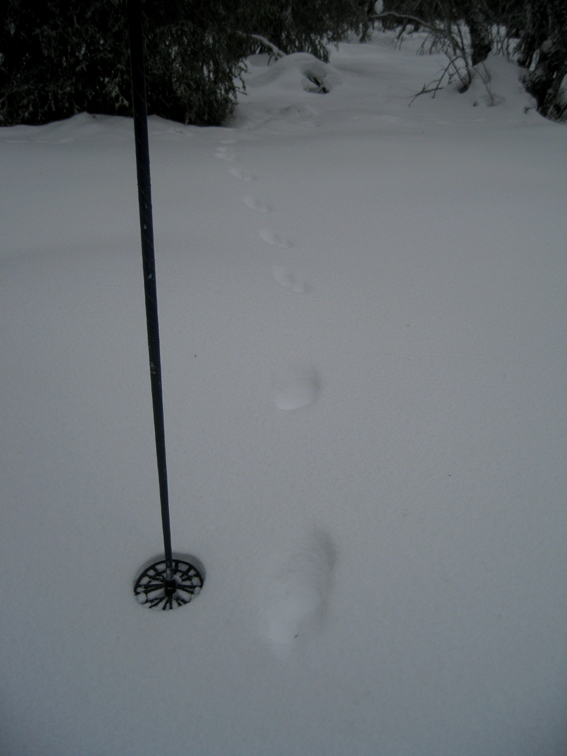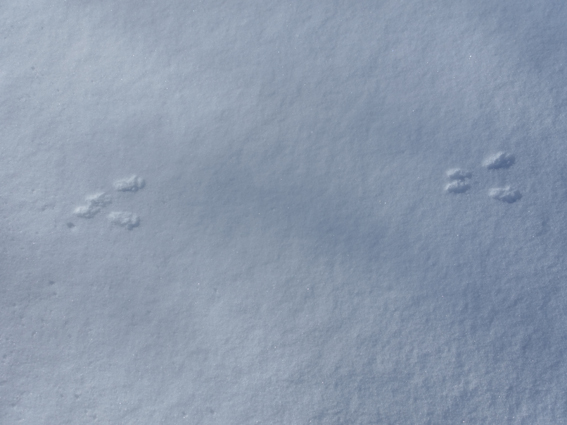Jouni Laaksonen 5.3.2018
Last week I told how wonderful it is to see animal tracks in winter. Also I listed the common, quite common and rare tracks you will see when ski touring in Finnish Lapland. That post also includes drawings of about 15 animal species.
Now I try to show you how beautiful the tracks can be, and in addition you get a chance to try your skills. There’s only a number before each photo. Take a paper and pen, or open a text document, and try to deduce which animal was in which photo. Answers you find at the bottom of this post.
In some photos there’s a box of matches. The length of the box is 5 cm and width is 3,5 cm. In some photos you see my forest skis, they are 7 cm wide. And the circle at the bottom of my ski pole (what is the English term?) is 11 cm wide.
How many did you get right? Tell us at the comment field!
1:

2:

3:

4 (two different animals here!):

5:

6:

7:

8:

9:

10:

11:

12:

Ok, that was it.
Are you ready for the answers?
Here they come:
- Fox. Fox typically trots straightforward and leaves a pattern like a pearl string.
- Willow grouse landed here and started to walk from one birch to another, to feed.
- Weasel. Two legs land in the same pit and the width of the pit is about 3…4,5 cm.
- Dog on left, on sand. Wolf on snow. A big dog like a leonberg can have as big a paw as wolf. Usually dog paws are smaller, though, and dogs move more erratically than wolfs.
- Black grouse. The bird has slept under snow and left a pile of droppings when getting up.
- Big paw tracks means bear, wolf, wolverine or lynx. Bear and wolverine have larger paws. These are roundish: lynx. Note how the animal has widened its toes as far out as possible, to avoid sinking in the snow.
- Pine martin. The width of the track pit is about the same as my ski pole, 11 cm. That means it is not mink or some smaller Mustelidae.
- Red squirrel. No other animal leaves this kind of a pattern in Finland.
- Otter. In theory otter leaps like pine martin, but in practice the body of otter usually touches snow between jumps, and the track looks like this. An otter likes to glide on snow in downhills, and it’s great fun to see such a track. You start to imagine the animal is having fun out there!
- Wolverine is not a big animal, but it has a thick fur and looks larger than it is. And it has very large paws, way bigger than even wolf. Wolverine typically jumps along like this when the snow is not hard.
- Capercaillie (maybe sometimes known also as wood grouse) is the largest bird that walks on ground in Finland. It is also quite a symbol to old-growth forests and wilderness, a great sight to see tracks, or a bird jumping up to flight in front of you.
- Reindeer. It is late springwinter, not very much of snow any more, and lots of needles on snow. Note reindeer droppings, a typical heap of small black pebbles.
* * *
It is still full winter, but the days are already much longer. Are you thinking of next summer’s holiday already? Next week I try to give tips in case you choose to travel to Finland and want to do some great hiking.


I got nine right! :-).
Wolf and dog went opposite in my guessing.
Is weasel lumikko or kärppä? I guessed the track to be the bigger one, kärppä, but online dictionary gives both animals when translating “weasel” from english to finnish.
Thank you for a nice test! 🙂
LikeLike
Good job, Anna! And thanks for pointing out that weasel may mean both lumikko and kärppä. I thought weasel is always the smaller one, lumikko in Finnish, and ermine the bigger one, kärppä. But seems weasel can sometimes mean both of them… So, number 3 is the smaller one, Mustela nivalis.
LikeLike